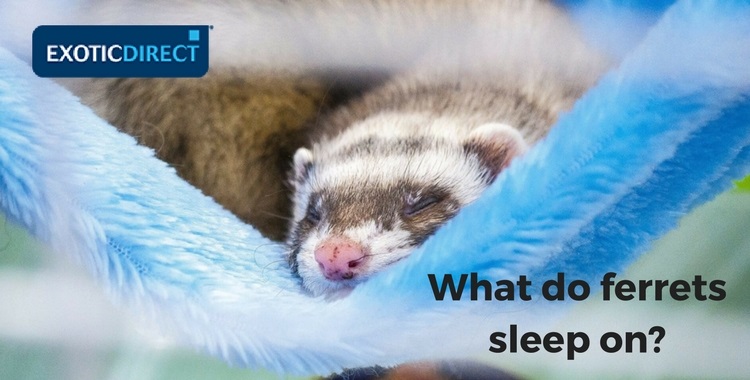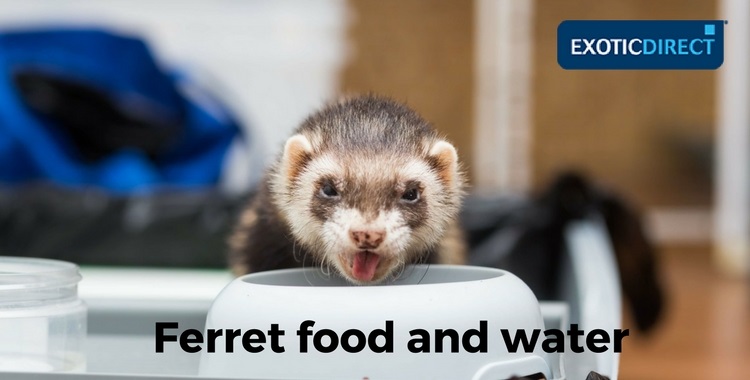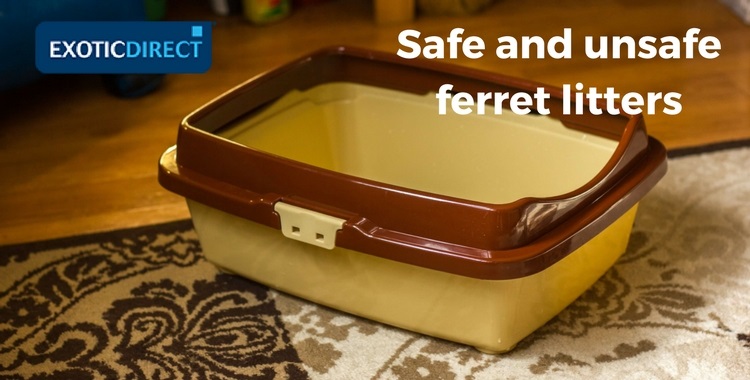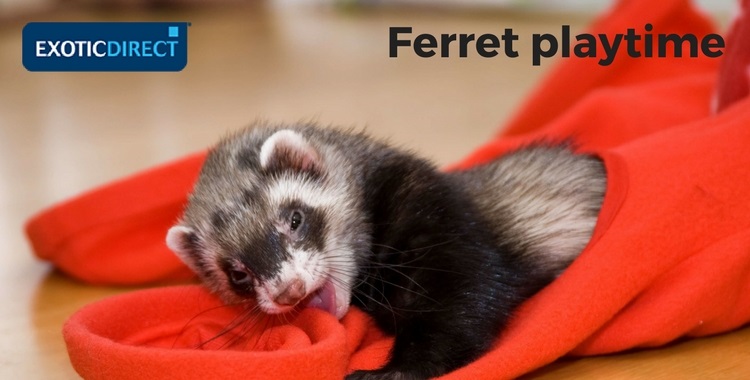Learn about cage setup, safe and unsafe litters, cleaning, toileting and playtime for your cute little ferret!
Is your ferret insured? Get a quote for up to £2,000 of vet fee cover | Insure up to 3 pets per policy | We’ve been insuring exotic pets since 1996 | Check out our customer reviews on Feefo.
Ferrets have been kept as pets for around 2,500 years, and are extremely popular! With their mischievous personalities, cute faces and lovable natures how can you not adore them? So what do you need when keeping an indoor ferret?
Ferret indoor cages
Your ferret’s cage should be large enough for one or multiple ferrets, should have several levels, and enough room for toys, food and a toileting area.
You should avoid mesh-based cages as your ferret’s claws can get caught in them, leading to sores and infections known as Bumblefoot.
The Ferret nation cage from Pet Planet is recommended by ferret owners on the Ferret Care & Support Facebook group.
You may also like to provide your ferret with a cage cover that will help her to sleep.
Jump to: Ferret runs and playpens | What do ferrets need in their cage? | What do ferrets like to sleep on? | Do ferrets require water? | Ferret food | What are ferrets allergic to? | Toxic litter | Safe litter | Poisonous wood | Cat litter | Pooping in the wrong place | Cage cleaning | Ferret toys | Harnesses and lead
Ferret runs and playpens
These can often be attached to your ferret’s cage, so she can come and go as she wants. If you buy a big enough cage it’ll mean she has more space to run around and play in safety. And it means that there’s less chance of her getting into mischief inside your home.
The Marshall Playpen, available on Amazon seems to be a well known choice for playpens. It’s a good idea to check if it will attach to your cage before you buy.
Check out Can ferrets live outside? Ideal temperature, and housing
What do ferrets need in their cage?
Ferrets need:
- A suitable bed or beds
- Litter tray or toileting area
- A water bottle and/or bowl
- Toys
- Tunnels or pipes
- Igloo/cave
- A playpen that can attach to the cage is a good idea
 Ferrets love to snuggle into hammocks
Ferrets love to snuggle into hammocks
What do ferrets like to sleep on?
Ferrets like to sleep in sleep sacks and in hammocks. Instead of a sleep sack you can also use old towels, or old clothes. These used to be common in days of old.
Sleep sacks have a soft lining, which makes them cozy and warm to snuggle into. And hammocks allow your ferret to curl up cozy.
Hammocks are also useful, as they provide an elevated sleeping area giving your ferret more room to play, as well as keeping her away from her food and toileting spot.
They also contribute to her playtime, as she can use them to climb to higher areas of her cage.
You’ll need to use something to tie the hammock to the cage with – you may choose clips, hooks or shoelaces. Just make sure they’re easy for you to remove and won’t hurt your ferret.
Heated pet beds for ferrets
You can buy snuggle safe microwave heating pads for your ferrets. Make sure they’re not too warm though, and that they’re always covered by a thick material, to prevent your ferret from burning herself.
Disposable ferret beds
You can create cheap, disposable bedding by using old T shirts or clothing, or picking up clothes from second hand shops.
You may want to use disposable bedding in order to reduce odours. However the best and cheapest way to do this long term is to regularly wash the clothing, rather than dispose of it. As over time, this will get expensive.
 Ferrets require clean, fresh water and are obligate carnivores
Ferrets require clean, fresh water and are obligate carnivores
Do ferrets require water?
Yes, ferrets absolutely require access to clean fresh water at all times.
You can use water bottles inside the cage, with a crock type bowl underneath it to catch the drips. However, you may find your furry friend will see the spout as a toy and try to play with it.
You can also supply water inside separate crock type bowls. As these are heavy, they should be harder for your ferret to move and tip over. Alternatively you could buy a metal bowl that fixes to the side of the cage – these are sold by Jollyes.
Research suggests that ferrets prefer drinking out of bowls rather than bottles.
If you do provide lots of bowls, make sure the water is changed regularly. You’ll probably find your ferrets like to ‘snorkel’, splash and drop food into the water. Keeping you well and truly on your toes!
Don’t be tempted to provide ice cold water for drinking as ferrets often don’t like it. This could lead to less drinking and dehydration issues.
Ferret food
Ferrets are obligate carnivores, meaning they must eat meat. Find out exactly what ferrets can and can’t eat.
What are ferrets allergic to?
If your ferret is sneezing, it could be caused by a number of things:
- Dust, dirt and hair – because ferrets like to ‘snorkel’ and they’re low to the ground they can inhale dust and dirt particles that can cause them to sneeze.
- Litter – litters can be very harmful for your ferret if you choose the wrong one. The wrong litter can not only be dusty, causing your ‘snorkeling’ ferret to sneeze, but it can lead to health problems.
- Cold and flu – ferrets can catch human viruses like cold and flu so you should be particularly careful if you own a ferret and you develop a cold.
If you do think your ferret does have a cold, you should take her to the vet.
- Scent spreading – a ferret may sneeze to spread his or her scent that’s released from glands behind his or her ears.
- Laundry detergent, fabric conditioners and fabric de-oderisers: Strong smelling products can cause your ferret to sneeze. Try switching to unscented products.
Are ferrets allergic to aubiose hemp bedding?
Generally ferrets shouldn’t be allergic to it, as it’s commonly used with small pets, and is generally dust free. If your ferret is sneezing, she may have been irritated dust, hair or scent in the atmosphere.
 Choose the right litter for your ferret to avoid health problems
Choose the right litter for your ferret to avoid health problems
Ferret toxic litter advice
- Wood shavings should be avoided as these can contain essential oils that can be toxic for your ferret.
- Clumping clay cat litters – as well as being dusty, once wet it sticks together and expands. As your ferret scoops the litter could get stuck inside her rectum, expand and cause a lot of health problems.
- Corncorb litter – this is also dusty and can contain moulds. If eaten it could also cause a blockage.
- Silica based litters – silica dust can be dangerous for your ferret if inhaled as it could lead to silicosis a condition where scar tissue builds up in your ferret’s lungs, causing the tissue to stiffen.
- There are some safe “lamorphous silicas” on the market, however, we’d suggest avoiding silicas all together. Better to be safe than sorry.
Ferret safe litter
Stick to a low dust litter – expert Lindsay Breed Tootle recommends paper pellets such as ‘Yesterday’s News’; a wheat based biodegradable clump litter such as Sweat Scoop; a corn based litter such as World’s Best Cat Litter; Pine pellets such as Feline Pine and Pine Pellet Stall Pine.
You can also buy wood stove pellets, however you should ensure they’re made of hardwood, with no softwood containing acids or phenols. You should also check the labelling as sometimes they’re labelled as unsafe for pets.
Safe for your ferrets will be those labelled as Denatured wood litter pellets – kiln dried to remove harmful phenols.
Advice taken from Lindsay Breed Tootle’s pdf on Choosing litter for your ferret. She is a member of the American Ferret Association’s Education Committee.
Wood poisonous to ferrets
Soft wood such as pine and cedar contain ‘essential oils’ the vapour from which can be toxic to ferrets. These aromatic hydrocarbon phenols can cause respiratory and liver damage, so should be avoided.
Hard woods such as Aspen are also advised against as suitable for ferret enclosures, according to Lindsey Breed Tootle of the American Ferret Association’s Education Committee.
Ferret enclosure substrate
The cage for an indoor ferret can be lined with lino or newspapers. Don’t use loose substrates such as wood shavings because as well as potentially releasing essential oils, which can be toxic for your ferret, they’ll also be very messy.
Can I use cat litter sand for ferrets?
The only cat litter that is safe for ferrets is a corn based cat litter such as World’s Best Cat Litter.
It’s not generally recommended to use a sand based cat litter as ferrets snorkel a lot and could ‘sniff’ the sand, forming a sand clot in their delicate sinus passages.
Ferret litter box tips
Ferret owner advice (via Facebook) suggests providing one litter tray per ferret and one extra. Put holes into the litter tray and fix it to the side of the cage, so that the ferret can’t tip it over or move it.
You can buy litter trays from Jollyes, or alternatively you can buy them from HomeDepot.com and trim them down to size to fit in a Ferret Nation cage.
Pooping in the wrong place
Your ferret may keep pooping in the wrong place, and not in her litter tray. Ferrets associate smells with where they can poop.
They generally won’t poop where they eat or sleep, so you need to make the ferret think that that area is a sleeping or eating area. You can do this by cleaning it thoroughly and putting their bedding/food there.
Unfortunately, some ferret owners still have trouble with their ferrets, who’ll poop wherever they like – regardless of it’s an eating or sleeping area.
Vanilla essence has been mentioned in Ferret Facebook groups and on Reddit as a solution. Wash some bedding with vanilla essence, so that it smells of it, and put vanilla essence into the corners where they shouldn’t be pooping.
The association between the bedding smell should help prevent your ferret from pooping in the area with the vanilla essence.
You may find this works – however the online advice can be contradicting. Some advice suggests the opposite is true, that ferrets will poop in the area that smells of vanilla. It’s probably best to give any suggestion a try, to see if it works for you.
Other Facebook group advice suggests washing the cage out with water and vinegar, and using puppy pads outside of the cage.
Baby gates for ferrets
Installing baby gates in your doorways can be a good idea to keep your ferret in one place.
Ferrets are full of fun and mischief, and will hide behind anything, try to get inside cupboards, and run around your house. A gate will keep your ferret in one place, so that you don’t have to worry about where she is.
You can also build a playpen – these can be pretty large and enclose your ferret in one place. Don’t forget to put lots of toys, water and a litter tray inside it though.
Ferret shampoo and bathing
You can bath your ferret using shampoo to keep her clean, however don’t bath her more than once a month.
More than this will result in stripping her skin and fur of vital oils, which her body will then attempt to replace more quickly. This will result in increased odour.
Frequent bathing will also dry out her skin, leaving it itchy and uncomfortable. So remember, no more than once a month (though playing in water is fine).
Ferret tubes
You can buy tubes for your ferret’s cage which will simulate her natural tunnelling environment. You can even put a small bed in there for her, which could simulate a burrow within the tunnel.
The tunnels can provide mental and physical stimulation and lots of fun.
Ferret cage cleaning
It’s important you keep your ferrets cage clean.
On a daily basis you should:
- Empty and wash any litter trays
- Clean up any toileting accidents outside the litter tray and wash down the area. You can use a specific spray for this
- Remove any uneaten food
- Remove and wash any soiled bedding
- Wash out drinking bottles using a bottle brush, and wash any water bowls
On a weekly basis you should keep your ferrets cage clean by:
- Washing and disinfecting all litter trays
- Washing all bedding
- Washing all toys
- Wiping down plastic toys with a bleach solution – don’t forget to rinse well
- Wiping down the inside of the cage, including the floor, bars and various floor levels with a bleach solution
 Ferrets love to play
Ferrets love to play
Ferret toys
You can provide cat toys, baby toys, tunnels and tennis balls for your ferret. You can also give her rope to play with as tug of war
Make sure her toys don’t contain any loose parts, string or bells, as these could detach and cause an internal blockage. Also avoid rubber toys, as bits can easily come off. Hard plastic toys are best.
It’s important to change the toys around weekly so that your ferret doesn’t get bored.
You can buy toys from online retailers or keep the cost down by visiting charity shops.
Playtime is really important for ferrets, and you should be spending at least two hours a day playing with her yourself.
Ferret harnesses and leads
If you want to take your ferret outside for a walk, you could try putting a ferret harness and lead on her.
An H style harness is best, as she’s likely to slip out of a collar, and the figure 8 harness can be very difficult to adjust – meaning one side is too loose, and the other too tight.
The harness shouldn’t have any metal parts as these can get hot in the sun. Nor should it have any Velcro fastenings, as these can come undone. Choose a sturdy nylon harness with plastic buckles. The buckles should be made of plastic.
You should be able to put your little finger between the harness and your ferret, once its on.
To help her to get used to it, let her wear it around the house and garden at first, firstly wearing the harness, and then gradually the leash. After a while you can then begin to hold the leash, so that she associates the gentle tugging with a required action. Reward her continuously throughout the whole process, to build an association between her actions and rewards.
Eventually she’ll have become used to the harness and the leash, and you’ll be able to enjoy some outside time together.
Ferrets and the rubbish
Try and put your rubbish bin somewhere out of the way of your ferret as she’ll like to climb in there, and burrow around, throwing rubbish around. Not the nicest of playtimes to have to clean up after!
And finally
The main points to remember are to give your ferret a large enclosure to live in, plenty of space to play, a variety of toys rotated regularly, and the correct type of litter and substrate.
She also needs to be secure in her surroundings, as ferrets love to explore and hide. You don’t want her to get hurt.
It’s a good idea to keep more than one ferret, as they love to spend time with each other. So keeping one pet could mean he or she will get lonely.
If you can’t have more than one, then just ensure you spend lots of time playing with her yourself. (Which we’re sure you’ll love).
You should also keep her housing clean and fresh, to prevent illness and reduce smells.
Is your ferret insured? Get a quote for up to £2,000 of vet fee cover | Insure up to 3 pets per policy | We’ve been insuring exotic pets since 1996 | Check out our customer reviews on Feefo.

